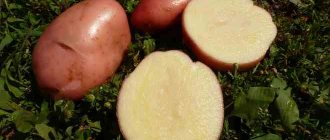Description of Arizona Potatoes
Today there are a large number of potato varieties, one of them is the Arizona potato.
The variety has excellent taste and has a beautiful appearance. Description of Arizona Potatoes
Characteristics of the variety
The Arizona potato variety was bred in 2013 and included in the State Register for the Central and Central Black Earth regions. The variety is mid-early, table, and is characterized by a yield in the range of 225-408 c/ha. The maximum indicator is up to 577 c/ha. The ripening period is 70-80 days.
Description of the plant
According to the description, the bush is medium, leaf type. Stems are straight and spreading. The leaves are green, large.
During the ripening period, the plant produces large corollas.
The root system is well developed.
Description of the root vegetable
The weight of one fruit is 112-150 g. The potato is oval and has small eyes. The skin is yellow. The pulp is light yellow. Potatoes contain starch in the range of 13-16%, so the fruits do not overcook and have a neat appearance when cooked.
Keeping quality of fruits is within 95%. The taste is good.
Advantages of the variety
Gardeners highlight a number of positive characteristics of the variety:
- resistance to potato cancer and golden nematode;
- keeping quality;
- good presentation;
- good taste;
- transportability;
- long storage.
Preparing for landing
The tubers are prepared before planting: they are germinated several weeks in advance. The planting material is taken out into a bright and warm room so that the fruits begin to sprout. Also, before planting, potatoes are sprayed with a growth stimulator: this helps increase yield.
Tubers should be beautiful and healthy in appearance, without damage. Damaged fruits must be discarded immediately, as they impair the formation of root crops. The soil in which the vegetable is planted should not be acidic, so wood ash is added to it. The planting area should be well lit. For Arizona, a place where various herbs or onions and cabbage used to grow is suitable.
Methods for planting tubers
Tubers are treated against pests before planting
Planting begins in early or mid-May, when the ground is warmed to a temperature of at least 12°C. Before planting, the soil is loosened and cleared of weeds and tops. On the day of planting, the soil is treated with potassium permanganate, and the fruits themselves are treated with pest control agents.
To increase the yield, the soil is mixed with peat and humus. The hole should be 10 cm deep, row spacing should be 30 cm, and the row width should be 70 cm.
Rules of care
Potatoes are easy to care for, but several mandatory rules must be followed. Gardeners recommend the following procedures:
- form high beds.
- water only in hot weather conditions;
- mulch the soil to retain moisture longer;
- the plant is fed during the formation of root crops; For this purpose, potassium and phosphorus are taken, but nitrogen substances are not used;
- 1 week before harvesting, cut off the tops: this way the root crops receive more moisture and nutrients;
- the harvested crop is given time to dry, and only then the potatoes are put into the cellar for storage.
Possible diseases and pests
The Arizona potato variety has strong immunity to potato canker and golden nematode, but is susceptible to late blight. It attacks stems and roots. To prevent disease, loosen the soil from time to time and reduce the amount of watering.
Germination of tubers before planting and treatment with a growth stimulant also help protect the crop from late blight.
Conclusion
The Arizona potato type has become especially popular in central Russia. The vegetable is undemanding in care, so even beginners can grow it.
Characteristics of the variety
The Arizona potato variety was bred in 2013 and included in the State Register for the Central and Central Black Earth regions. The variety is mid-early, table, and is characterized by a yield in the range of 225-408 c/ha. The maximum indicator is up to 577 c/ha. The ripening period is 70-80 days.
Description of the plant
According to the description, the bush is medium, leaf type. Stems are straight and spreading. The leaves are green, large.
During the ripening period, the plant produces large corollas.
The root system is well developed.
Description of the root vegetable
The weight of one fruit is 112-150 g. The potato is oval and has small eyes. The skin is yellow. The pulp is light yellow. Potatoes contain starch in the range of 13-16%, so the fruits do not overcook and have a neat appearance when cooked.
Keeping quality of fruits is within 95%. The taste is good.
Arizona Potatoes
Arizona Potatoes
One of the highest-yielding mid-early ripening potato varieties. The originator is Dutch. According to the State Register, it has the properties and characteristics listed below.
Culture:
Potato (Solanum tuberosum L.)
Year of inclusion in the register:
2013
Direction of use:
dining room
Ripening period:
mid-early
Plant type:
rn resistant to cancer, pathotype I and to golden potato nematode (R01)
Admission region:
Central, Central Black Earth, North Caucasian
Originator(s):
"AGRICO", POSTBUS 70, 8300 AB EMMELOORD NETHERLANDS
The potato variety "ARIZONA ®" is included in the State Register database for the Central Black Earth and Central regions of the Russian Federation.
Description
Growing
The key to a good harvest of Arizona potatoes
is the competent selection of seeds, proper care when planting and growing, fertilizing, and soil selection. The most suitable soils for growing seed potatoes, the Arizona variety, are as follows:
- Loamy and clayey
- Sandy and sandy loam
- Chernozems
Among other things, it should be noted that it is better to plant Arizona potato seeds in areas where perennial grasses, legumes and winter crops grew. The soil must be loosened and freed from weeds. It is also worth keeping in mind that it is not advisable to plant Arizona seeds after nightshades such as tomato, peppers, and wolfberry. This is fraught with infection with the same diseases as tomatoes and peppers. Before applying fertilizers, you should pay attention to the type of soil. It is better to plant Arizona potatoes during the waning moon. In general, potatoes are a very light-loving plant and should be planted taking into account the shade from trees, houses, etc. There are a lot of options for planting potatoes, but three parameters remain unchanged:
- groove depth - 20 cm
- distance between tubers 30 cm
- 60 cm - distance between rows
Potatoes are also sprinkled with ash, compost and other fertilizers are added. Arizona potatoes require constant watering, but it is recommended to stop saturating the soil with moisture before harvesting. Hilling is an integral attribute of growing Arizona potatoes. The first hilling procedure is carried out when the bushes are already strong and reach a height of 20 cm. In the future, hilling should be done after rain or after watering, but not more than 3-4 times per season. After hilling, the root system is saturated with oxygen and becomes stronger. In general, growing potatoes of the same variety in one plot costs no more than three to five years in a row. Afterwards, it is recommended to change the variety to a more disease-resistant one.
Diseases and pests
Disease resistance of Arizona potato variety is average
, so you need to frequently carry out preventive inspections of bushes. List of diseases and pests affecting the Arizona potato variety:
- Scab
- Late blight
- Gray rot
- Wireworm
- Colorado beetle
Description
Arizona potatoes are classified as early table potatoes. The bushes are of medium height, with straight spreading stems. The leaves grow quite large.
Massive oval-shaped tubers gain an average weight of 110-150 g over the course of a season. The skin of the potatoes is yellow, and small eyes remain on the tubers. The pulp is light yellow (photo). The starch index corresponds to table varieties - 13-16%. The ripening period of the crop is 70-85 days. The Arizona potato variety is excellent for winter storage (keeping quality 95%).
Description of the Arizona potato variety
Arizona potatoes are a variety imported from Holland. Included in the Russian State Register in 2013. Passed successful tests and was approved for cultivation in most regions of Central Russia:
- middle lane;
- Chernozem region;
- North Caucasus.
Refers to unpretentious crops, but is demanding on moisture. Arizona potatoes can be grown in other regions (southern Urals, Siberia) provided that they are regularly watered, especially during drought periods.
Main characteristics of the variety:
- mid-early – ripens in 70–80 days;
- table – starch content from 13% to 16%;
- medium height – 50–60 cm;
- leaf type plant.
The Arizona potato bush is semi-erect, rather spreading, so when planting, leave at least 70 cm between furrows. The leaves are large, green, and closed. Corollas are medium or large. The flowers are white.
The tubers are elongated oval in shape, large in size, reaching 5–7 cm in diameter, weighing 110–150 g, but they can be larger. Each Arizona potato bush produces 8–10 root crops. The skin is smooth, yellow, the eyes are small, barely noticeable. The pulp is light yellow, does not darken when cut, boils moderately, and tastes pleasant. Score based on tasting results - at least 4 points out of 5.
Arizona potato tubers weigh more than 100 g
Attention! Product yield ranges from 88 to 97%. The tubers store well, so the variety can be grown both for personal consumption and for sale.
Landing
An important stage before planting the Arizona variety is the processing and germination of tubers. Select healthy, undamaged material. In order for the sprouts to grow faster, the potatoes are taken to a warm, well-lit place.
A common and popular remedy is “Epin”. Arizona potato tubers treated with the drug can withstand late frosts down to -5 C. The bushes grow more powerful and stronger, and the root crops ripen faster. For spraying, one ampoule (0.25 ml) is diluted in 400 ml of water. This amount is enough to process approximately 200 tubers. The procedure is carried out one day before planting Arizona potatoes.
A lighted place is allocated for potato beds. Non-acidic soil is preferable. Crop rotation is an important factor for obtaining a good harvest. Potatoes grow well after onions, cabbage or various greens.
The Arizona variety is planted in the first half of May - when the soil has warmed up sufficiently. The site must be prepared - loosened, weeds removed. On planting day, the soil is treated with a solution of potassium permanganate. Tubers are also sprayed with special means. Fungicide "Matador" will protect planting material from the Colorado potato beetle, wireworm, late blight, and Alternaria. Dilute 30 ml of product in 200 ml of water - this is enough to spray 30-35 tubers. To ensure high-quality processing, Arizona potatoes are laid out in one layer and sprayed first on one side and then on the other.
A little peat mixed with humus is added to holes approximately 10 cm deep. The row spacing is made 65-70 cm wide. And in the row, a distance of 25-30 cm is maintained between the holes.
Arizona potatoes are quite unpretentious. However, following certain care rules will help increase productivity:
- for better potato growth, high beds are formed;
- after watering, the soil must be mulched;
- approximately 5-7 days before digging up the root crops, the tops are cut off.
The choice of irrigation regime is influenced by several factors: climatic features of the area, composition and structure of the soil. If rains are frequent, then there is no need to specifically water the Arizona potato plantings. It is better to loosen the soil regularly. Loosening is also called “dry watering” because it preserves soil moisture.
When growing the Arizona variety in any region, it is important to carry out agronomic practices and plant feeding in a timely manner.
How to grow
The Arizona variety is completely unpretentious in care. It needs to follow the regime of watering, loosening the beds, removing weeds, hilling bushes, and applying organic and mineral fertilizers.
Dates, scheme and rules of planting
The timing of planting potatoes depends on the climatic conditions of the region. In areas with a warm climate, planting work begins in mid-April. In regions characterized by a late arrival of spring, planting is planned for the first ten days of May.
Open, sunny areas where onions, cabbage, beans, peas, greens, lupines, and winter crops were previously grown are best suited for potato beds. The most favorable soil is sandy loam, loamy or black soil.
In autumn, the soil is dug up and fertilized with humus. In the spring, the area is sown with green manure (flax, oats, wheat, rye, mustard), and after 3-4 weeks it is mowed and embedded in the ground. Plants prevent the spread of pathogenic fungi and saturate the soil with nitrogen and air.
River sand, peat, and sawdust are added to the heavy, forgotten soil. Using litmus strips, a special device with a long probe, which can be purchased at gardening stores, the acidity of the soil is determined. Optimal pH = 5.2-5.7. Excessively acidic soil (pH less than 4.5) is deoxidized with dolomite flour, slaked lime, chalk, and ash.
Three weeks before planting, the tubers are taken out of storage and taken out into the sunlight for greening and germination. 24 hours before planting, potatoes are soaked in growth stimulants. Such products not only increase productivity, but also prevent infection by pathogenic microflora. The most common stimulants are Epin and Zircon.
On the day of planting, the prepared holes are spilled with a strong solution of potassium permanganate, and the tubers are treated with the Matador fungicide to protect against the Colorado potato beetle.
The depth of the holes should not exceed 10 cm. A handful of peat mixed with the same amount of humus is added to each of them. The distance between the holes is 30 cm. The row spacing is 60–70 cm.
Reference. The optimal soil temperature for planting Arizona potatoes is +10°C.
Rules for caring for potatoes:
- Water once a week until the buds appear, 3-4 liters per bush using a fractional method: first pour out part of the water, and after complete absorption - the rest. During the dry period, the frequency of watering is doubled and sprinkling is arranged. Water consumption - 12-14 l. The best way to regulate moisture is to install a drip system.
- The soil is loosened after each watering, preventing the formation of a dense earthen crust.
- Hilling up is combined with weeding. This procedure provides additional ventilation of the root system and facilitates access to moisture. The first hilling is carried out when the sprouts grow by 10-20 cm, the second - after 15-20 days. The soil must be moist.
- Mulching is an additional, but not mandatory procedure. Hay, straw, sawdust, and pine needles are laid out on the beds to retain weeds in the soil, promote the growth of weeds, and repel insects.
Fertilizing is applied three times per season according to the following scheme:
Hilling and feeding
The first time hilling is carried out when the potato stems grow 15-20 cm high. The second time (after 2-3 weeks) the soil is carefully loosened and rolled onto the stems, forming mounds.
What is noteworthy is that hilling is important when growing Arizona potatoes in regions with different climatic features. In dry areas, this technique will prevent the soil from overheating and help maintain soil moisture. And in places with cool and rainy weather, thanks to hilling, the earth will be loosened, which will ensure the flow of air to the root crops.
Fertilizer application
Experienced gardeners recommend feeding plants three times a season:
- As soon as Arizona potato shoots appear, nitrogen-containing compounds are applied. Pale foliage is a signal of nitrogen deficiency. You can use a solution: 500 ml of mullein and 15 g of urea are diluted in 10 liters of water. 500 ml of the mixture is poured under each bush.
- During bud setting, potassium-based fertilizers are applied. This will promote the setting and growth of tubers. In 10 liters, dilute 15 g of potassium sulfate and double superphosphate, half a glass of wood ash. For one bush, 500 ml of solution is enough.
- Approximately 20-25 days before digging the Arizona potato crop, a mineral-organic mixture is applied. For 10 liters of water take 30 g of superphosphate and a glass of slurry. For one bush, 50 ml of fertilizer is enough.
The best option is a combination of fertilizing and hilling the bushes.
Caring for the variety after planting
Caring for Arizona is basically no different from caring for other potato varieties - watering, fertilizing, tilling the soil.
Fertilizer
The need to feed potatoes is due to their weak root system, many large tubers, and also the fact that in the fall, valuable substances are removed from the soil along with the harvested crop. The main purpose of fertilizer is to replenish nutrients in the soil.
When cultivating this potato variety, it is recommended to apply fertilizer three times per season:
- Initial feeding . Produced by nitrogen-containing substances after plant emergence. A signal of a plant's nitrogen deficiency is its pale foliage. The solution used is: 500 ml of mullein and 15 g of urea diluted in 10 liters of water. Composition consumption: for each bush - 500 ml of solution.
- Second feeding . During the formation of buds. Potassium fertilizers are applied: 15 g of potassium sulfate, 15 g of double superphosphate and 0.5 cups of wood ash diluted in 10 liters of water. Consumption: for each bush - 500 ml of solution. This feeding promotes the formation and growth of tubers.
- Third feeding . Mineral-organic. Apply 20–25 days before harvest. 30 g of superphosphate and a glass of slurry are diluted in 10 liters of water. Consumption: per bush - 50 ml of fertilizer.
Watering
Watering is done in hot weather. The first time it is carried out after the appearance of stem shoots 5–10 cm above the ground in the center of the bush. Water consumption is 3-4 liters per plant. Since Arizona does not tolerate sudden changes in humidity, fractional watering is effective: first, only part of the required volume of water is poured under the bush, and after it is absorbed, the rest of the liquid is poured out. This ensures uniform soil moisture. Before the buds form, the plantings are irrigated once a week.
When the first flower stalks appear, watering is increased to twice a week at a water consumption of 12–15 liters per bush. The liquid is poured out in small portions in the morning before sunrise or late in the evening. The optimal method is drip irrigation; if this is not possible, you need to run water along the grooves from a hose or by sprinkling. When the first signs of foliage wilting appear, watering continues, but with a decreasing dose - 3 liters of water per bush. Complete drying of the stems is a sign of crop maturity and a signal to stop watering.
Diseases and pests
To obtain a voluminous and high-quality harvest, it is important to notice signs of disease in time and use the right means to combat dangerous insects.
Late blight (brown rot) easily affects the plant. In favorable conditions, when the weather is warm and humid, it quickly attacks the entire planting. The source of rot can be soil, infected tops, or affected neighboring plants (especially the nightshade family). The initial signs are darkening of the lower leaves on the bushes. The entire plant (aerial part and root system) is gradually affected. It is necessary to start fighting for the harvest when the first symptoms appear - planting is sprayed with fungicides: Skor, Ditan, Bravo, Reglon super. Preventive measures are of particular importance - the rules of crop rotation are observed, Arizona potatoes are not planted in the lowlands, thickening of the beds is not allowed, and bushes are hilled.
Common scab is a fungus that attacks the skin of tubers. The disease leads to the loss of presentation of Arizona variety tubers, the taste of potatoes deteriorates, the amount of starch decreases, and the shelf life of root crops is reduced. The disease develops in dry, hot weather. Control methods: use of physiologically acidic fertilizers (manganese sulfate, ammonium sulfate), culling of infected tubers during planting, regular soil irrigation (especially after the budding phase).
The Colorado potato beetle and its larvae eat the green part of the potato, which leads to the destruction of the bush. The insect overwinters in the ground and as soon as warm weather sets in, it comes to the surface. If your Arizona potato plantings are small, you can collect insects and larvae by hand. A more effective method is the use of biological agents. The beds are sprayed with Agrovertin, Bicol, Colorado. Popular folk remedies include treating bushes with a solution of birch tar (100g of the product is diluted in a ten-liter bucket of water), and an ash-soap solution.
Harvesting
The tops are mowed approximately 7-10 days before digging up the tubers, which speeds up their ripening. It is advisable to harvest in dry weather. The best root crops are left for planting for the next season. Sick and damaged potatoes are thrown away.
In order for Arizona potatoes to dry, they are left on the field for 1-2 hours, provided the air temperature is not high. On a bright hot day, it is better to scatter the crop under a canopy, otherwise burns may appear on the fruits.
The Arizona variety is very popular due to its easy care and excellent growth at low temperatures.
Collection, storage and use of crops
7-10 days before harvesting, the tops are mowed to stimulate the ripening of tubers. The collection is carried out in sunny, dry weather. Potatoes are cleared of soil, sorted, and the best medium-sized specimens are left for planting next season. Rotten, infected root vegetables are thrown away.
The harvest is left to dry for two hours in the open air in cloudy weather or under a canopy in sunny weather. Then they are laid out in prepared boxes made of wood, plastic, linen bags or mesh. The optimal temperature for storing potatoes in the cellar is +2...+4°C with a humidity of 70-80%.
In a city apartment, the harvest is stored on an insulated balcony or loggia. To do this, use double boxes inserted into each other like a nesting doll. The space between them is filled with sawdust or foam. There are thermal containers on sale - “balcony cellars” with heating.
Arizona potatoes are good in any form - boiled, baked, stewed, fried. The tubers do not darken after cooking and do not become overcooked, maintaining their structure and rich taste.
Features of the variety
The bush is medium in size, spreading, and contains large green leaves. Potato stems are straight. Has a developed root system. When ripe, relatively large potato corollas are formed.
One root vegetable can weigh from 112 to 150 grams. It has an oval shape. The eyes on potatoes are small. The peel is yellow. The potato pulp is light yellow. Potato fruits can contain from 13% to 16% starch. When boiled, the potatoes hardly become soft and have a relatively neat appearance.
Arizona potato description of the variety suggests that the variety is well preserved during the winter. Keeping quality is 95%. The variety has good taste.
Agrotechnics of cultivation
Before planting, you need to make sure the quality of the potatoes is good. It is unacceptable to use those that have mechanical damage.
Before planting, you need to make sure that the soil is not too acidic. If it needs to be adjusted, then one way to improve the properties is to mix the soil with wood ash.
Sometimes growth stimulants are used. One of the common options is “Epin”. If you take one ampoule of the drug and dilute it in 400 ml of water, then this amount is enough to treat 200 tubers. This procedure is carried out a day before planting.
In order for this potato variety to grow well, it needs good lighting in the area.
If onions or cabbage previously grew at the planting site, then this area is suitable for growing potatoes.
Planting time for Arizona potatoes is early to mid-May. Before starting work, you need to make sure that the soil is suitable for its characteristics - it is already quite dry. It is important that at the time of planting the soil temperature is not below 12 degrees.
Of course, before starting work, you need to clear the area of weeds and debris. After this, the ground is loosened.
Important! It is recommended to treat the soil with a solution of potassium permanganate on the day of planting potatoes. Root crops should be sprayed with pest control agents.
During planting, soil is poured into previously prepared holes, which is pre-mixed with humus and peat.
The holes for this variety are made less deep than usual - only 10 centimeters. Their dimensions are 30 centimeters in length and width. Planting is done in beds, the distance between which should be approximately 30 centimeters. Moreover, the width of the bed is taken equal to 70 centimeters.
Arizona potatoes in the beds
This variety is considered to be relatively unpretentious in care.
But you must follow certain rules:
- It is recommended to make the planting beds relatively high;
- It must be remembered that watering is only required in hot weather;
- It is recommended to mulch the soil to help it retain moisture;
- Nitrogen fertilizers are not used for fertilizing; potassium and phosphorus fertilizers are used;
- Fertilizing is done at the time when root crops are being formed;
- No later than a week in advance, it is necessary to trim the tops. In this case, the roots will receive more nutrients;
- After harvesting, you need to spend some time drying the potatoes. This will help him survive the winter better.
Part of the harvest
Rules of care
Potatoes are one of the most unpretentious crops to care for. However, there are a number of simple rules, following which will help you get the most out of the variety.
- It is not recommended to water the tubers until the green part grows to 10-15 cm.
- Do not water the tubers after flowering, as during this period the likelihood of developing late blight increases significantly.
- The bushes need to be hilled up. No matter how badly you feel about this procedure, it can significantly increase productivity. Gardeners have noted that those who do not hill up potatoes lose up to 25-30% of the harvest.
- Mulch is used to protect the area from the spread of weeds and retain moisture. This is not a necessary procedure, but it makes caring for Arizona potatoes much easier.
- There is no need to constantly feed the crop (especially with nitrogen). Potatoes are a specific vegetable, for which regular autumn fertilizer is sufficient. Otherwise, an excess of minerals will lead to the fact that it will begin to accumulate them in its composition.
- 7-10 days before the planned harvest, the tops are removed, leaving only 10-12 cm. Firstly, this procedure will allow the tubers to receive more moisture and nutrients in the last days of the growing season. Secondly, harvesting will be greatly simplified.
- Always keep the area free of weeds. Grass has a depressing effect on any crop. Even if you see small areas of grass on your property, remove them. Weeds suck nutrients from the soil, leaving it very poor.
- Do not take the harvested crop directly to the cellar. It needs to dry well and only then can it be stored.
Comparison with other varieties
This variety has a number of important advantages compared to others:
- Its peculiarity is that it has good resistance to pests and diseases. For example, high protection against golden nematode and potato cancer is known;
- Keeping quality, which is 95%, is a very high indicator. This potato variety is able to survive the winter with virtually no losses;
- High-quality commercial appearance can also be considered one of the advantages of the variety. If you buy it for a holiday table, it will delight everyone who tastes it;
- The variety has excellent taste;
- Since such potatoes hardly spoil when properly stored, they are suitable for transportation over long distances.
This variety of potatoes can be purchased not only in Moscow, but everywhere in Central Russia.
Arizona Potatoes
Today, breeders have developed many potato varieties that can produce good yields even in unfavorable conditions. One of these is Arizona - the creation of specialists from the Dutch company Agrico. The Arizona potato variety was developed in 2013, and today it is successfully grown in the central part of the Russian Federation, Ukraine, Belarus and Moldova.
It is on the list of leaders among its own kind, and this is over 7000 varieties! Vegetable growers fell in love with it primarily for its culinary and commercial qualities. There are other advantages to this potato, but first things first.
Characteristics and description of the Arizona variety
These potatoes belong to the early table-type varieties, the tubers of which ripen approximately on the 80th day from the moment of planting in the ground. If the weather is favorable and all care rules are followed, young potatoes can already be dug up on the 60th day. Arizona bushes are of medium height, with large dark green leaves growing on spreading stems. A distinctive feature can also be considered a well-developed, powerful root system and large corollas that the plants produce during the ripening period.
Each bush produces up to 10 smooth oval tubers, gaining a weight of 100-150 g by the end of the season. There are practically no small potatoes. The yield of the variety varies from 350 to 450 c/ha, and with a successful combination of circumstances and proper care it can exceed 500 c/ha. A few superficial eyes are visible on the pale yellow potatoes. The pulp of the same shade has excellent taste and culinary versatility. Arizona potatoes are used in the preparation of a wide variety of dishes; they can be either the main ingredient or an additional one. During cooking, peeled or cut potatoes do not darken and retain their natural color for a long time. The starch content is average - 13-16%, like most other table varieties.
Separately, it is worth mentioning the quality of these potatoes. The yield of marketable tubers can reach up to 97%, which is a very high figure. Keeping quality also deserves praise. With properly organized storage, the shelf life of Arizona potatoes is 93-95%.
The variety is resistant to many common crop diseases: nematode, various types of mosaic, cancer. Immunity to common scab, as well as late blight of tops and tubers, is assessed as average. The variety easily tolerates sudden increases in temperature and prolonged droughts.
Description of the variety
Arizona potatoes are positioned by breeders as an early table variety. The growing season lasts up to 80 days; with exceptional care, the harvest can be harvested after 70 days, and dug for testing after 55-60 days.
Despite the fact that the variety positions itself as a table variety, it is noted for its unrealistic yield - up to 577 c/ha. On average, at home they get at least 350-400 c/ha, naturally, with good and proper care.
The tubers are large, with a yellow shell and light yellow flesh. One bush produces up to 10 potatoes; there are practically no small items.
Starch content – 14-17%. The weight of mature tubers is up to 150 g. Keeping quality is 92-96%.
Tubers are suitable for preparing various dishes: mashed potatoes, fried potatoes with mushrooms, soup, baked potatoes, etc. Also, it is worth noting that the pulp does not become darker when heat treated or damaged.
The variety is resistant to diseases and parasites such as:
It has average resistance to late blight of tops and tubers.
The bush is small, spreading. The stems are abundantly covered with large leaves. The leaf color is dark green.
Features of cultivation
To grow a good potato harvest, you must adhere to all the rules of agricultural technology and the recommendations of experts. The Arizona variety is no exception. It also needs care, consisting of a number of activities that are carried out throughout the growing season. And it begins with the preparation of planting material and subsequent planting.
Landing rules
Seed preparation is one of the most important conditions for successfully growing Arizona potatoes. Medium-sized potatoes (60-70 g) without signs of disease or mechanical damage are selected for planting. Two weeks before planting, the selected tubers are transferred to a warm, bright room for germination. To increase productivity and strengthen immunity to pathogens, planting material is treated with a growth stimulant. It is recommended to do this the day before planting. Today, the most popular stimulant is Epin, thanks to which planting tubers can withstand frosts down to -5 degrees, strong healthy shoots are formed, and root crops ripen faster. One ampoule of this drug is enough to treat 200 tubers.
Immediately before planting (on the same day), sprouted potatoes are treated with a protective agent. For example, Matador will do. This is a contact fungicide that protects tubers from pathogens of late blight and alternaria.
Arizona potatoes are planted in late spring, when the soil has warmed to a suitable temperature. In warm regions - in early May, in cold regions a little later, approximately in the middle of the last spring month. For this variety, a standard planting scheme is recommended:
- distance between rows – 60-70 cm;
- distance between bushes – 25-30 cm;
- embedment depth – 10-15 cm (depending on climatic conditions and soil structure).
If planting is carried out in infertile, poor soil, it is advisable to add a little humus and peat to each hole. The easiest way to determine the amount of nutrients in the soil is by color. The lighter the soil, the more nutritious organic matter it needs.
Competent care
The Arizona variety is considered unpretentious, but like any other it needs care. To get a high yield, experts recommend feeding the plants three times per season. The first fertilizing with nitrogen-containing fertilizers is carried out after the emergence of seedlings using the “under the bush” method (mullein, urea). The second is when the buds begin to form. This time, potassium fertilizers are used to promote the formation and growth of tubers (potassium sulfate, wood ash). The third mineral-organic fertilizing is carried out 3-4 weeks before harvest (superphosphate, slurry).
Arizona potatoes do not require much moisture to grow and develop well, so plants should only be watered in hot weather. One bush requires only 3-4 liters of water. Watering should be fractional, since the variety does not tolerate sudden changes in humidity. That is, first you need to pour only half of the water under the bush, and when it is absorbed into the soil, pour out the rest. This ensures more uniform soil moisture.
After flower stalks appear, the watering rate for one plant can be increased to 12 liters, and then gradually reduced. By the time the foliage begins to wilt, the dose should be no more than 3 liters. Drying of the stems is a signal that watering is no longer necessary.
No less important agricultural techniques are weeding and hilling. The first time weeds are removed when the sprouts rise 3-4 cm above the soil surface. Then - as they appear and grow in the beds. The first hilling is carried out on potato bushes that have reached 10-15 cm in height. Repeated - after 2-3 weeks. After some time, the piles destroyed by rain and wind should be corrected. To make your work easier and protect the piles from the effects of natural factors, you need to hill up with moist soil. In dry weather, it is better to do this work after artificial irrigation.
Description of Arizona potatoes. Growing and caring for the variety
Potatoes are one of the most common products. With the development of agronomy and vegetable growing, more and more potato varieties with different characteristics are appearing. The Arizona variety is one of them.
Characteristics, description and photo
Below are photos of potatoes:
Advantages
- Excellent presentation, which is not lost during transportation.
- Excellent taste.
- Good preservation and keeping quality.
- Resistance to some diseases and pests.
- Drought resistance.
- High yield.
Flaws
Among the disadvantages of the variety, one can highlight only its sensitivity to diseases such as common scab and late blight of leaves.
Comparison table with other potatoes
| Variety | Arizona | Aladdin | Saprykinsky | Queen Anne | Labella |
| Tuber weight, g | 110-150 | 108-185 | 80-100 | 80-150 | 78-102 |
| Productivity, c/ha | 225-408 | 450-500 | 300-400 | 393-457 | 176-264 |
| Starch content, % | 13-16 | Until 21 | 14-16 | 12-16 | 13-15 |
A Brief History of Breeding
The originator of the Arizona variety is Dutch. Included in the state register in 2013. Admission region:
- Central.
- Central black earth.
- North Caucasian.
Landing
Inventory
Standard agricultural technology is used for cultivation. Planting potatoes is considered one of the most labor-intensive, so it’s worth getting:
- walk-behind tractor or potato planter;
- potato harvester.
Soil preparation
The best soil for planting this variety is chernozem:
The soil temperature should not be less than 10°C. The place where potatoes will be grown must be well lit. In the fall it should be dug up and fertilized with organic matter. Right before planting, the soil is loosened to remove weeds. You can also add wood ash to normalize the acidity (it is worth considering that the normal pH for a plant is 5-6).
On the day of planting, the soil must be treated with permanganic acid. In areas where onions, cabbage, all kinds of greens, legumes and winter plants previously sprouted, potatoes will develop better. But it is better not to plant Arizona where nightshades have sprouted: it can become infected with diseases to which these crops are sensitive.
Under no circumstances should you grow potatoes in the same place for too long. After 3-5 years of cultivating a variety in a row, it is worth changing it to one more resistant to the disease.
Preparation of material
- For planting, it is worth taking healthy and whole medium-sized tubers. Before planting, the fruits must be germinated for several weeks. In order for them to start sprouting faster, they should be placed in a bright and warm room.
- To increase productivity, the tubers should be treated with a growth stimulator before planting.
- On the day of planting, potatoes should also be treated with a pest repellent.
Boarding time
Depending on the climate of the region, the time for planting potatoes varies from the end of April to the first half of May.
- In central Russia and the Leningrad region, it is recommended to plan planting work for May.
- The Moscow region starts half a month earlier and ends in May.
Dates may vary due to weather conditions. It is also believed that it is better to plant Arizona during the waning moon.
Scheme
The distance between tubers should be 20-30 cm, the distance between rows should be 60-70 cm, and the depth of the grooves (holes, if the soil is light) in the southern regions up to 15 cm, in the northern regions - up to 20. For better yield, peat can be added to the grooves , mixed with humus. It is also better to form high beds.
Hilling
Hill up potatoes by rolling moist soil with small lumps onto the bottom of the stem while simultaneously loosening it. Hilling is done twice a season.
- The first time - after the potatoes grow 10-20 cm.
- The second time - after 14-20 days after the first procedure.
Thanks to hilling, the root system is strengthened and saturated with oxygen.
Watering
Potatoes are drought-resistant, so you don’t have to worry too much about watering the plants. Some gardeners recommend watering only during hot weather. The plant is watered for the first time after it has grown 5-10 cm. One bush should receive 3-4 liters of water.
The Arizona variety does not tolerate sudden changes in humidity , so it is advisable to carry out fractional watering.
To do this, only part of the water is poured onto the plant and the rest only after it is absorbed. Before flower stalks appear on the bushes, watering is carried out once a week. After the buds appear, watering should be increased to twice a week, and the bush should now receive 12-15 liters.
Water the potatoes before sunrise or late in the evening. If the plant begins to wilt, you should reduce the amount of water, but continue to water steadily. Water for irrigation should be left in the sun to keep it warm.
Loosening
Loosening is carried out if potatoes are grown in a place with a rainy climate. By loosening the soil, moisture lasts longer.
Weeding
To maintain the conditions necessary for the proper development of potatoes, they must be weeded. This promotes air flow into the soil, moderate soil moisture and gives it the desired softness. Arizona is weeded for the first time after the shoots grow 2-4 cm. After that, another 2-3 times, depending on the weather.
Fertilizer
When growing the Arizona variety, fertilizer should be applied three times per season.
- The first fertilizing is carried out after the rise of the first potato shoots. For this feeding, nitrogen-containing compounds are used. The solution consists of 500 ml of mullein and 15 g of urea per 10 liters of water. Each plant should have 500 ml of solution. If the bush suffers from nitrogen deficiency, this will be noticeable by pale foliage.
- The second time feeding is carried out when the buds begin to appear. This time potassium fertilizers are introduced. Thanks to them, the setting and growth of potato tubers is improved. To prepare the solution, you need to dilute 15 g of potassium sulfate, 15 g of double superphosphate and half a glass of wood ash in 10 liters of water. Each plant needs 500 ml of solution.
- The last feeding is carried out 20-25 days before harvest. Mineral-organic fertilizer is used. The mixture is made from 30 g of superphosphate and a glass of slurry per 10 liters of water. There is 50 ml of mixture per bush.
Additional care tips
- Fertilizing and hilling potatoes can be combined, then the effect of both procedures will be stronger.
- After watering, the soil is mulched, this promotes crop growth.
Diseases and pests
As mentioned above, the Arizona potato variety has average resistance to scab and late blight. Common scab usually develops during the hot summer months. The fungus damages the surface of the tubers, after which they lose their presentation. The best prevention of scab is regular watering of potato plantings during dry periods. But if, despite the measures taken, symptoms of the disease still appear, then the problem will have to be eliminated by other methods. For example, using fertilizers such as ammonium sulfate or manganese sulfate.
Late blight most often occurs at high humidity in warm weather. First, the lower leaves of the affected plant darken - this is the first sign of the disease. After some time, the entire above-ground part, root system and tubers become infected. This disease spreads quickly, so crop rescue should begin as soon as the first symptoms are detected. Vegetable growers fight late blight on potatoes by treating the plantings with fungicides. The most effective are Bravo, Skor, Reglon super and Ditan.
As for insects, the only serious enemy of the variety remains the Colorado potato beetle. If you allow it to multiply, the larvae will quickly eat the leaves on the bushes, which will negatively affect the quantity and quality of the harvest. In small areas, striped pests and the larvae they deposit can be collected by hand, taken away and burned by dousing them with any flammable liquid. In vast fields you cannot collect beetles by hand; other methods are needed here. On farms, insects are successfully combated by spraying potato plantings with various insecticidal protection products. Bicol, Karbofos, Agrovertin, Regent, Colorado are suitable for such purposes.
Collection and storage
On the 60th day from the moment of planting, Arizona potatoes can already be dug up for testing, after 10-15 days, dry tops can be mowed, and after another week, harvesting can begin. It is better to dig up potatoes in dry weather. Potatoes removed from the ground are sorted and sorted, with the obligatory rejection of damaged and diseased specimens. After 2-3 hours of drying, the harvested crop is sent for storage in a cellar or basement. It is important that the humidity in the storage does not exceed 80%. The optimal air temperature is 2-3 degrees above zero.










